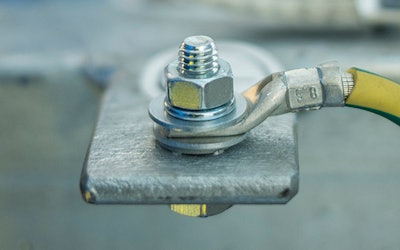
One of the biggest areas of concern identified in my pool equipment installation review series (swimmingpoolsteve.com) is the lack of bonding on pool equipment. At least 80% of the pools that were inspected were lacking bonding to the casing of either the pump, the heater or both. This is the type of installation deficiency that can go unnoticed for years since everything apparently functions properly. What happens with this type of problem is that the equipment is not protected against galvanic corrosion, which can result in advanced decay of metal components. In the case of saltwater pools, which have more conductivity than traditional chlorine pools, the rate of damage due to galvanic corrosion can be many times more.
A swimming pool should have a bonding grid — not having one is a serious safety concern. While the vast majority of pools in North America are bonded with an equipotential bonding grid, this will often only apply to the pool structure itself. Swimming pool equipment pads should be included in the bonding loop since they are, of course, part of the pool system. Each component of your pool system that contains metal should be bonded directly to the casing of the machine. Filters do not usually require bonding unless they are ancient and made from stainless steel, but both pumps and heaters almost all will have a bonding lug somewhere on the casing. If you can fi nd one of these bonding lugs and there is not a copper wire connected to it, it means that your equipment has this common deficiency, and you should have an electrician look at your installation and verify the presence of a bonding grid.
If you do not bond your pool equipment there is the risk that the equipment itself will become the anode in a galvanic couple with other metal components in or around your pool. If this happens, the anode metals will deteriorate at an advanced rate, a phenomenon called galvanic corrosion.
Only the anode metal will corrode, while the other metal will experience enhanced resistance to corrosion from a process known as cathodic protection. This is a predictable electromechanical process, and one that can actually be used to help protect your pool equipment. By not bonding the equipment, you allow a potential difference (voltage) to exist between each component. By bonding the equipment, you are forcing each piece to have the same electrical potential, which limits the potential for damage from galvanic corrosion.
By adding an anode to your pool plumbing installation, and by connecting the anode to the bonding grid, you effectively make the rest of your pool equipment the cathode in a galvanic couple. As discussed, this will provide cathodic protection to your pool equipment, which results in increased rust resistance. The anode you add will take the brunt of the corrosion damage, sacrificing itself during this process. Simply replace the anode over two to three years, or when the anode metal has reduced in size by half. This is how a sacrificial anode can help to protect important (and expensive) pool equipment from damage and this is something that all pools should have, and all salt water pools must have.
SOLUTION FOR A LACK OF BONDING
All swimming pool equipment that contains metal should be bonded. Simply inspect your pump, heater and any control panels for an empty bonding lug as pictured above. If you can locate a bonding lug that is empty, or if you fail to find a bonding wire that connects to all of your pool equipment, be sure to have an electrician locate your existing bonding grid and add your pool equipment into it.
|
Bonding Versus Grounding As It Applies To Swimming PoolsGrounding and bonding are different entirely and serve two different purposes for swimming pools. Bonding is the process of connecting all metal components together with a low-resistance conductor. Being tied together as such means each metal component carries the same electrical potential. From a theoretical standpoint, each individual component could be viewed as "one component" even though in the real world they are spread all over your backyard. If you were to take a multimeter and measure the conductivity between all different components, they would, in theory at least, all have no electrical resistance in between them. In other words, they are at the same electrical potential. (Useful fact: Electrical potential is another way of saying "voltage.") The reason that bonding needs to exist is manifold: If a difference in electrical potential exists, a current pathway can be created, which results in a sudden balancing of electrical potential in the form of an instantaneous current transfer. This current spike can be very dangerous to a big, pink, watery meat sack floating in a swimming pool. To prevent humans from becoming a wire shunting two different electrical potentials, a bonding grid is used to keep everything in and around a pool at the same electrical potential. If all metals within a pool are held to the same electrical potential, this will reduce the damaging impact of galvanic corrosion. Galvanic corrosion is a destructive current transfer that can result from swimming pools acting as a primary battery where dissimilar metals are submerged in an electrolyte solution. When you hear people talk about saltwater pools having problems, this is the problem that they are talking about. Grounding is the process of providing a low-resistance pathway to ground for any powered device (like a pool pump, for example). If the electricity should escape the system by way of a fault, for example to the casing of the device, the current will transfer to ground, which will cause the circuit breaker to trip. If the device is not grounded, the casing can become energized but fail to trip the breaker as it is, "electrically isolated." Isolated, that is until a big, pink, watery meat sack comes along to clean out the pump strainer basket... When bonding and grounding are used in conjunction, a swimming pool becomes electrically safe for people to be in and around, and it reduces the potential for harmful damage from the electromechanical process of galvanic corrosion. The bonding grid effectively ties all metal components in the pool area to the same electrical potential, and since that bonding grid is grounded (usually to the main electrical service panel of the house), all metal components in the bonding grid have the lowest possible electrical potential: zero. In theory. In practice, there are many factors that impact localized anodization in swimming pools — where errant or generated electrical potentials exist from a variety of sources with the end result being a constant, tiny trickle of electrical current. This is due to the fact that the ground of a house service panel may in fact be slightly different than the electrical potential of the actual ground the pool is sitting in...but that is a story for another day. |
Steve Goodale is a second-generation swimming pool expert located in Ontario, Canada. You can learn more about Steve, as well as swimming pool construction, maintenance and repair from his website: SwimmingPoolSteve.com













































